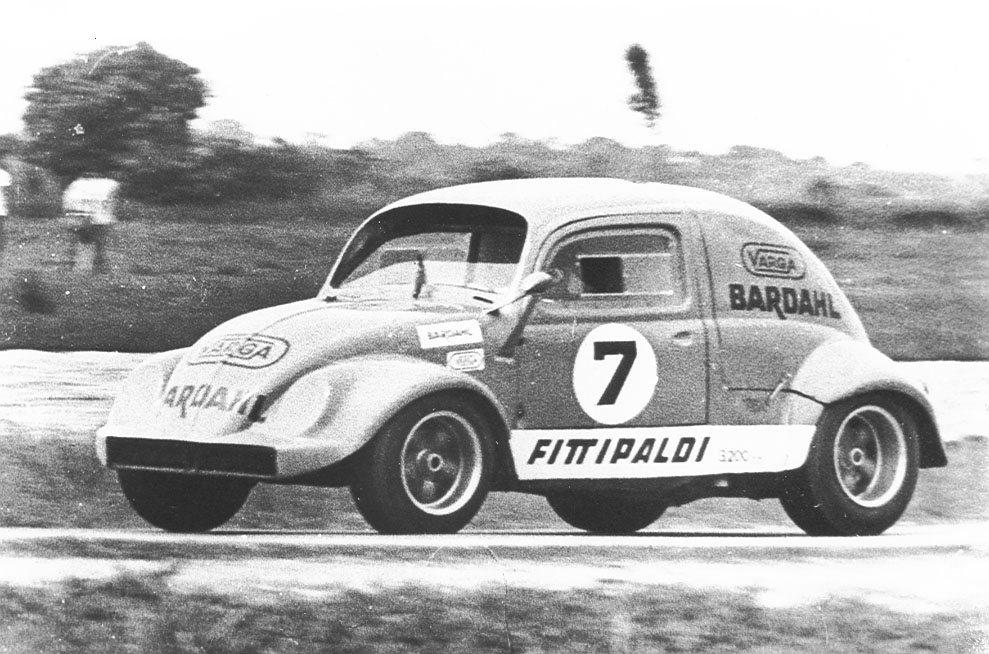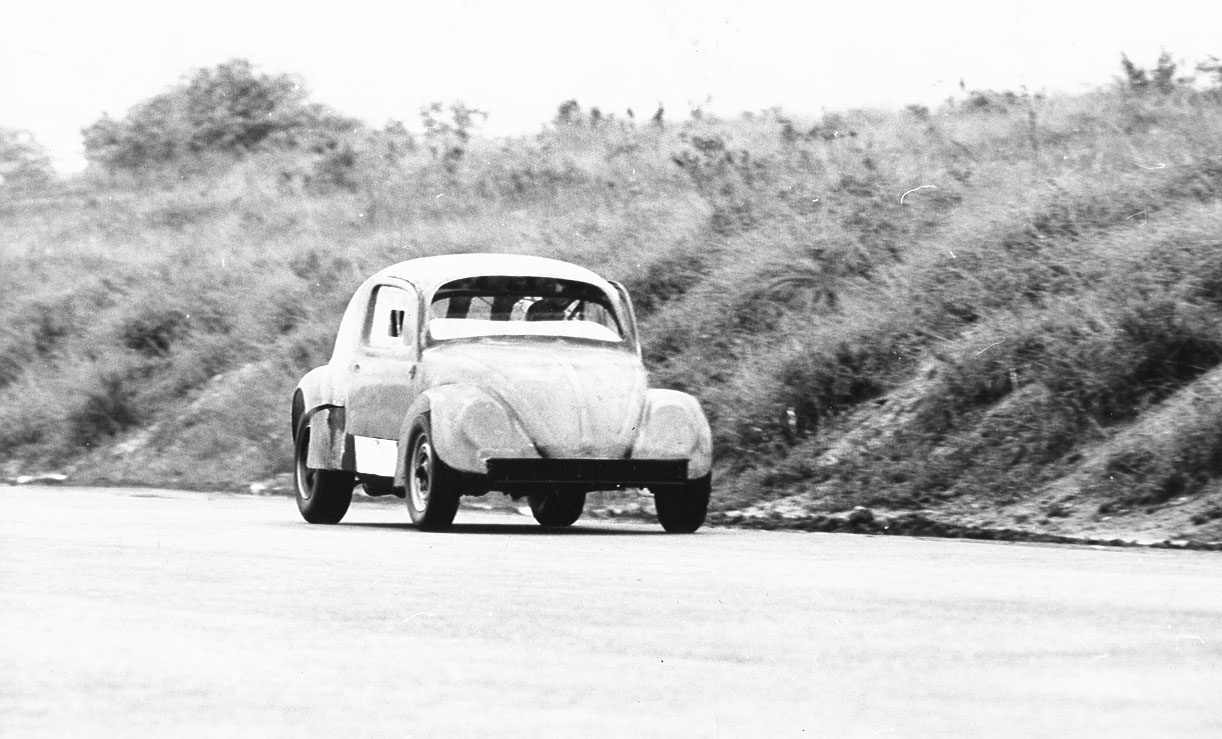Fittipaldi 3200 VW Bimotor

Designed in 1969 by Ricardo Divila, this fibreglass bodied and twin engined car came about after
Divila picked up a copy of Hot Rod magazine from a Congonhas airport newstand in São
Paulo. The Alfa Romeo engined prototype design the Fittipaldi's were building was running late due to
a delay in the castings for the uprights, and a car was needed for the Rio 1000 Kms. The opposition had
upped the ante by buying new cars - they now faced a Lola T70, a Ford GT40, and an Alfa Rome TT33 for
Carlos Pace and Marivaldo Fernandes.
They had previously developed a VW Beetle, but it wasn't powerful enough. An idea dawned on Divila. The
old Jacarepagua circuit was much twistier than today, and what you wanted was a good power to weight
ratio. Divila reached for his slide-rule and worked it out. What about doing a twin engined race car
with minimal weight?
The original design layout was really done on the back of a fag packet, with additional work done
on some Churrascaria Interlagos paper napkins (Churrascaria is the Brazilian Barbecue house). The
majority of the chassis was built by Deusdedith José de Sena, following chalk marks on the floor.
Darci de Medeiros was in charge of the engine preparation. This was a young team - de Sena was in his thirties, and de Medeiros
and Divila were in their twenties. This perhaps accounts for the wild ideas, although they had experienced
men to help them. The carburretor linkage was built by "Brizzi", the grand old mechanic of the team, linking
all four Weber DC045's together, and it surprisingly never jammed.
The chassis was constructed by taking a standard VW platform, and cutting it just behind the drivers
seat area. The back was thrown away, and replaced with a tubular frame. The VW front suspension and steering
was retained, but Porsche drum brakes were fitted instead. VW type swingle axles were used at the rear
to allow the use of lots of negative camber. The fibreglass shell was done by a company called Glaspac,
run by two British expatriates (Jerry Cunningham and Donald ?) in Brazil. Two standard 1600cc VW engines (hence
the 3200 designation) were fitted for the first tests, but these were later tuned by de Medeiros, who
replaced the cam-shafts and upped the compression ratio using Porsche parts. The engine displacement
was also upped to 2200cc. During testing in the three weeks from build to first race, the front end of the
rear engine's crank-shaft was ripped off, so a shorter stroke crank was put in place and the engines'
displacement was reduced, but still above 1600cc.
The rear engine was attached normally through a Porsche transaxle units, reduced from five gears to
four due to the engine's proclivity for destroying first gear. The front engine was connected to the rear
by a rubber joint, and had its crank phased at 90 degrees to the rear to sequence the power correctly.
Cooling was achieved two ways. Firstly, based inside the front bumper were two oil coolers (see the top diagram).
Secondly, standard air cooling was also used. The front windscreen was angled backwards more than normal, which
which left a gap between the top of the windscreen and the roof, thus creating an air-scoop. This channelled the
air over a false ceiling beneath the roof to the flex hoses feeding the engine. The fuel tank was
of 100 litres capacity and made of aluminium, housing the ethanol fuel. It had to be specially shaped
to fit in the car - it was shaped to form the drivers seat!
The entire car weighed only 407 kg, with the unpainted fibreglass shell weighing in at only 17 kg. Total power
was 410 bhp. This may not have been much, but the competition it would be up against were some 300-350 kg
heavier. Tyres were imported Firestone Indy's, with 9 inch fronts and 10 inch rears on magnesium rims.
During the first test at Interlagos in November 1969, the rear bodywork was blown clean off, but it
was still entered in the Rio de Janeiro 1000 Kms held on the Guanabara circuit. Carlos Pace qualified
first, at 1:30.9 in a new Alfa Romeo 33 2.0 litre V8. The Fittipaldi 3200, driven by Wilson Fittipaldi,
qualified 2nd at 1:36.3, ahead of a Porsche special, a Lola-Chevrolet R70, and a Ford GT40. It wasn't
expected to last for long during the race, but with Emerson Fittipaldi driving, it was in 3rd at the
end of lap 1, 2nd by lap 5 behind Pace, and comfortably holding off the Lola and GT40. But before the
end of the first half hour, the car broke down - it had broken its gearbox.
The car raced once more in its twin-engined format, once again breaking down, this time with Wilson
Fittipaldi driving. The front engine was removed, and it was raced at Mineirao, with Wilson Fittipaldi
racing Toninho da Matta. It was eventually sold off to Adu Celso, who did several races with it in
single engine form.
Before the second engine was removed, Volkswagen telephoned the Fittipaldi's to ask if they could send
some engineers to look at the car, as they couldn't understand how it could out-race a Lola-Chevrolet.
Eight engineers arrived to look it over, and they still couldn't understand how it out out-raced it....

The twin-engines. The rear clam-shell body work is propped open with a broom handle, clearly
visible in the middle of the photo.

Coming up the Reta Oposta at Interlagos, with Pirelli CN87 Cinturatos tyres. The car had major
wheelspin problems with on full power....

On the banking at Jacarepagua, Rio de Janeiro. The first run of the car - straps were later added
to hold it all together, although there were always problems with the doors. The tops of them frequently
blew open at speed.
|